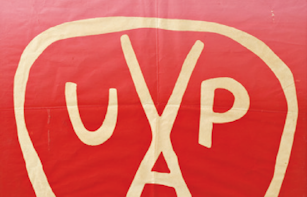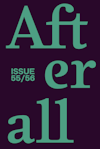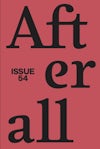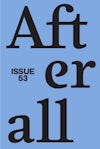
Issue 44
Autumn/Winter 2017
Issue 44 of Afterall journal is organised around the theme of Ethno-Aesthetics and Institutions.With essays on Pia Arke, Maria Thereza Alves, Rustam Khalfin, Hans Ragnar Mathisen, and more.
Editors: Ana Bilbao, Charles Esche, Candice Hopkins, Wanda Nanibush, Charles Stankievech.
Founding editors: Charles Esche, Mark Lewis.
Table of contents
Foreword
Contextual Essays
- The Delicate Difference Between ‘Thinking at the Edge of the World’ – Carola Grahn
- Early Contemporary Art in Post-Soviet Mongolia: Where is the Green Horse Galloping Now? – Tsendpurev Tsegmid
- A Conversation between Manuel Borja-Villel and Marcelo Expósito – Manuel Borja-Villel & Marcelo Expósito
Artists
Qiu Zhijie
- The Lazy Project, In Honour of the Rider, The Flying White, Base Level: The Clay Project
Pia Arke
- Ethno-Aesthetics
- On Pia Arke – Stefan Jonsson
- Being and Origin – A Presentation of Pia Arke’s Exhuming Gesture – Carsten Juhl
Maria Thereza Alves
- Realism in the Work of Maria Thereza Alves – Paloma Checa-Gismero
- Wake in Guangzhou: Steps for an Ecological Aesthetic – Mara Polgovsky Ezcurra
Rustam Khalfin
- ‘The Issue of Corporeality Through the Prism of Tactility’ in Rustam Khalif’s Art – Yuliya Sorokina
Hans Ragnar Mathisen
- Names and Places: The Cartographic Interventions of Hans Ragnar Mathisen – Jan-Erik Lundström
- A Hand-drawn Map as a Decolonising Document – Maria Therese Stephanse
Events, Works, Exhibitons
- Now and Then: Commodity and Apparatus – Victor Burgin
- ‘Struggle as Culture’: The Museum of Solidarity, 1971-73 – María Berríos
- Amo la montaña/I Love the Mountain – Silvia Rivera Cusicanqui
Foreword
Written by Candice Hopkins
In 1995, Greenlandic artist Pia Arke put forward an observation that holds true today: ‘There are quite a few of us who belong neither in the West, nor in the marginalised rest. … We need an expansion of the border; … that will seriously disturb the binary logic of First and Third World relations’ .
For Arke, one means of achieving this was through the critical practice of what she termed ‘ethno-aesthetics’, a position of ‘a narrative of the West seen from the outside … from a point of view of the “other”’. These words are a fitting entry into this issue of Afterall, which brings together points of view, practices and histories from influential artists such as Pia Arke, Rustam Khalfin, Hans Ragnar Mathisen and Maria Thereza Alves as well as other fascinating accounts, including the one of the Green Horse Society in post-communist Mongolia. Mongolia, as well as Kazakhstan, Greenland and Sápmi, are places that might be considered on the periphery of practices of modern and contemporary art, yet the essays in this issue resituate the formation of contemporary practices from the perspective of those living and working in these places. In her visual performative essay, Aymara activist and sociologist Silvia Rivera Cusicanqui asks: ‘From where do we speak when we rant against “Western culture”?’ Carola Grahn notes that ‘far away depends on where you start’, as this already ‘assumes a centre and a periphery’. Her contribution is a call for Sami art to also find a way to address the familiar and the everyday by emerging from the trappings of the exotic and manufactured margins.
In Mongolia, contemporary art begins to shape itself with the post-communist art movement Nogoon Mori (Green Horse Society, GHS), which emerged in the early 1990s out of perestroika and the Mongolian Democratic Revolution. Tsendpurev Tsegmid details in her essay how its members broke with the tradition of Socialist Realism and its attendant aesthetic and intellectual suppression by looking afresh at pre-communist Mongolian culture (the time when Genghis Khan emerged from history to replace Vladimir Lenin as a figurehead). The GHS found their theoretical basis not in the urban centre, but in the spirituality, aesthetics and cultural practices of the remote provinces where people lived off the land in much the same way as had been done for thousands of years. Not without incident, their experimental approach to learning led them to develop the Green Horse Modern Art College; students who trained at that experimental school continue to influence contemporary practices in the country today.
The ideologies and rituals of the nomadic influenced Rustam Khalfin’s art writing, videos and performances. In Kazakhstan, he formed his own strand of contemporary practice based on the idea of a Eurasian utopia emerging out of the collapse of the Soviet Union. Merging nomadologywith the ‘corporeal landscape’, as Yuliya Sorokina articulates in her text, Khalfin’s practice was centred on radical estrangement, love and longing. In one of Khalfin’s performances, a nude man leads a horse into the gallery space. With a piece of clay in place of a saddle, an imprint was created of the space between horse and rider, the horse’s back and the underside of the man. For Khalfin, this elementary gesture symbolised what he considered a ‘degree zero’, a space of true potential, tactile evidence of a nomadic perception and way of being in the world. This issue also includes an insert by Chinese artist Qiu Zhijie, a reproduction of two works from his All Living Things series (2017), which suggest further links between world-making and the body.
Purchase
The publication is available for purchase. If you would like specific articles only, it is also available individually and to be downloaded as PDFs.
Purchase full publication
Buy via University of Chicago Press
Buy via Central Books
Purchase individual articles
Buy via University of Chicago Press




